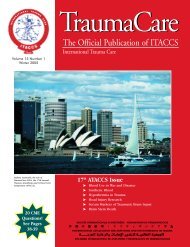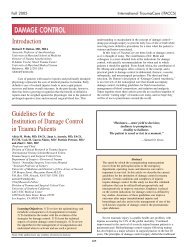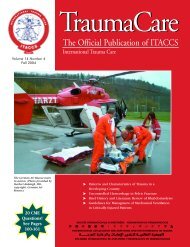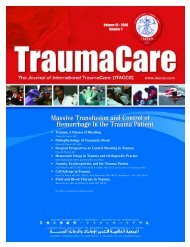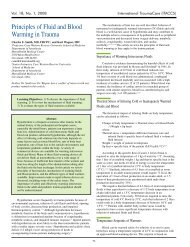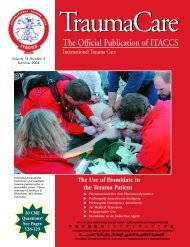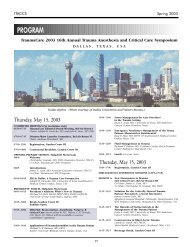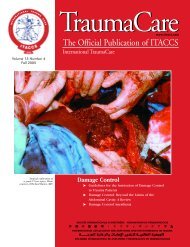Massive Transfusion for Trauma is Appropriate - International ...
Massive Transfusion for Trauma is Appropriate - International ...
Massive Transfusion for Trauma is Appropriate - International ...
You also want an ePaper? Increase the reach of your titles
YUMPU automatically turns print PDFs into web optimized ePapers that Google loves.
ITACCS Summer 200523. Yomtovian R, Lazarus HM, Goodnough LT, et al. A prospectivemicrobiologic surveillance program to detect and prevent the transfusion ofbacterially contaminated platelets. <strong>Transfusion</strong> 1993;33:902-9.24. Do A, Jarvid WR. <strong>Transfusion</strong>-related infection. In: Schlossberg D, ed.Current Therapy <strong>for</strong> Infectious D<strong>is</strong>ease. St. Lou<strong>is</strong>, MO: Mosby-Yearbook;1996:340-3.25. Sapatnekar S, Wood EM, Miller JP, et al. Methicillin-res<strong>is</strong>tantStaphylococcus aureus seps<strong>is</strong> associated with the transfusion ofcontaminated platelets: a case report. <strong>Transfusion</strong> 2001;41:1426-30.26. Kuehnert MJ, Jarv<strong>is</strong> WR, Schaffer DA, et al. Platelet transfusion reactiondue to Yersinia enterocolitica. JAMA 1997;278:550.27. Smith RN, Yaw PB, Glover JL. Autotransfusion of contaminatedintraperitoneal blood: an experimental study. J <strong>Trauma</strong> 1978;18:341-4.28. Wollinsky KH, Oethinger M, Büchele M, et al. Autotransfusion—bacterialcontamination during hip arthroplasty and efficacy of cefuroximeprophylax<strong>is</strong>. A randomized controlled study of 40 patients. Acta OrthopScand 1997;68:225-30.29. Dzik WH, Sherburne B. Intraoperative blood salvage: medicalcontroversies. Transfus Med Rev 1990;4:208-35.30. Byard RW, Harr<strong>is</strong>on R, Wells R, et al. Glycine toxicity and unexpectedintra-operative death. J Forensic Sci 2001;46:1244-6.31. Khan-Ghori SN, Khalaf MM, Khan RK, Bakhameez HS. Loss of v<strong>is</strong>ion:a manifestation of TURP syndrome. A case report. Middle East J Anesth1998;14:441-9.32. Bull BS, Bull MH. The salvaged blood syndrome: a sequel tomechanochemical activation of platelets and leukocytes? Blood Cells1990;16:5-23.33. Tawes RL Jr, Scribner RG, Duval TB, et al. The cell-saver and autologoustransfusion: an underutilized resource in vascular surgery. Am J Surg1986;152:105-9.34. Standards <strong>for</strong> Perioperative Autologous Blood Collection andAdmin<strong>is</strong>tration. 1st Ed. Bethesda, MD: American Association of BloodBanks. 2001.35. Edna TH, Bjerkeset T. Association between blood transfusion and infectionin injured patients. J <strong>Trauma</strong> 1992;33:659-61.<strong>Massive</strong> <strong>Transfusion</strong> <strong>for</strong> <strong>Trauma</strong><strong>is</strong> <strong>Appropriate</strong>Panna Codner, MD, and Marianne Cinat, MD 1University of Cali<strong>for</strong>nia Irvine Medical CenterDepartment of SurgeryDiv<strong>is</strong>ion of <strong>Trauma</strong>, Burns, and Critical Care1101 The City Drive, Building 53, Route 81Orange, CA 92868 USAmecinat@uci.eduLearning Objectives: 1) To review the h<strong>is</strong>tory of bloodtransfusion and the science of blood banking. 2) To reviewthe literature regarding massive blood transfusion andoutcome. 3) To understand adverse consequences ofmassive blood transfusion, including hemostatic,metabolic, electrolyte, and immune. 4) To understand theepidemiology, pathogenes<strong>is</strong>, clinical manifestation, andtreatment of transfusion-related acute lung injury. 5) Toreview an example of a massive transfusion protocol andunderstand when to activate such a protocol, and whoshould be responsible <strong>for</strong> activating the protocol.AbstractThe h<strong>is</strong>tory of blood transfusion dates back to the mid-17thcentury. Scientific advances in transfusion therapy stillpers<strong>is</strong>t today. Major developments have included bloodtyping, preservation, storage, fractionation, and theemergence of component therapy. Although early reportedsurvival rates following massive transfusion were d<strong>is</strong>mal(6.6%), recent literature shows survival rates of 40% to60%. Improved survival has been attributed toimprovement in trauma care prov<strong>is</strong>ion, improvedrewarming techniques, damage control celiotomy, andimproved blood banking technology. With massivetransfusion, the recognition of blood as a <strong>for</strong>m oftemporary organ transplantation has been realized. Theadverse consequences associated with massive transfusionare now diagnosed and treated earlier. Th<strong>is</strong> article reviewsthe h<strong>is</strong>tory, outcome, and potential complicationsassociated with massive blood transfusions.148H<strong>is</strong>tory of Blood <strong>Transfusion</strong> and Component TherapyThe h<strong>is</strong>tory of blood transfusion dates back to 1628 whenWilliam Harvey, an Engl<strong>is</strong>h physician, d<strong>is</strong>covered the circulation ofblood (Table 1). Soon thereafter, the earliest known blood transfusionwas attempted. The first successful blood transfusion occurred in1665, and the first claim of successful human blood transfusion wasmade by the American physician Philip Syng Physick in 1795. Latermilestones include the first successful whole blood transfusion,ant<strong>is</strong>eptics to control infection during transfusions, and saline as a“blood substitute.”Although blood transfusions were becoming more common, theadverse consequences ar<strong>is</strong>ing from donor-recipient incompatibilityDrs. Codner and Cinat have no conflicts of interest to d<strong>is</strong>close.
ITACCS Summer 2005Table 1. H<strong>is</strong>tory of Blood <strong>Transfusion</strong>Year D<strong>is</strong>covery1628 William Harvey demonstrates circulation of blood1665 Richard Lower per<strong>for</strong>ms first blood transfusions1795 Philip Syng Physick per<strong>for</strong>ms first human bloodtransfusion1867 Joseph L<strong>is</strong>ter <strong>for</strong>mulates ant<strong>is</strong>eptic theory1901 Karl Landsteiner identifies human blood groups1912 Reuben Ottenberg coins terms “universal donor” and“universal recipient”1914 Richard Lew<strong>is</strong>ohn reports use of citrate <strong>for</strong> long-termblood anticoagulation1915 Richard Weil develops refrigeration and storage of blood1932 First blood bank establ<strong>is</strong>hed1939-40 Karl Landsteiner, Alex Wiener, Philip Levine, and R. E.Stetson d<strong>is</strong>cover Rh blood group system1953 Carl Walter and W. P. Murphy invent plastic blood bag1971 Hepatit<strong>is</strong> B surface antigen testing begun1990 Blood tested <strong>for</strong> hepatit<strong>is</strong> Cwere not fully understood. In 1900, Karl Landsteiner d<strong>is</strong>covered thethree human blood groups, A, B, and O. H<strong>is</strong> colleagues, Decastelloand Sturli, added the fourth group, AB, in 1902. Reuben Ottenbergper<strong>for</strong>med the first blood transfusion using blood typing and crossmatchingin New York. He also recognized the mendelianinheritance of blood groups and the universal utility of group Odonors. The terms “universal donor” and “universal recipient” werenot coined until 1912.The next major advance in transfusion medicine occurred withthe development of long-term anticoagulants such as sodium citrate,which allowed extended preservation of blood. Th<strong>is</strong> immediatelytrans<strong>for</strong>med transfusion from a direct to an indirect procedure. At thesame time, Richard Weil developed procedures <strong>for</strong> refrigeration andstorage of anticoagulated blood. The addition of a citrate-glucosesolution extended the viability of collected blood to several days.The ability to preserve blood <strong>for</strong> longer than a few hours led tothe first blood bank being establ<strong>is</strong>hed in a Leningrad hospital in1932. Th<strong>is</strong> first blood bank ushered in the science of blood bankingand processing. In 1953, a greater level of soph<strong>is</strong>tication wasachieved with the development of the plastic blood bag, which wasinvented by Fenwal Laboratories. The bag made it feasible tofractionate and use the blood’s various components. 1Why fractionate blood? Fractionation allows a specific productor coagulation factor to be transfused with less volume. Differentblood component products also require different storagetemperatures; there<strong>for</strong>e, fractionating blood allows more effectivestorage and product management.The technique <strong>for</strong> fractionation <strong>is</strong> as follows: whole blood <strong>is</strong>centrifuged at 5000 g × 5 minutes at 4˚C (“hard spin”) resulting infractionation of the blood into red blood cell concentrates andplasma. If platelets are required, centrifugation must take place at22˚C and a “soft spin” (2000 g × 3 minutes) <strong>is</strong> used. Th<strong>is</strong> providesan additional fraction in the <strong>for</strong>m of a platelet-rich plasma. Furthertherapeutic components can be extracted by applying “flashfreezing”technology to plasma. For instance, if plasma <strong>is</strong> flashfrozenand thawed <strong>for</strong> 12 to 18 hours at 4˚C, most of the plasmabecomes liquid, and cryoprecipitated factor VIII <strong>is</strong> generated. Insummary, traditional fractionation yields a number of usefulproducts: red blood cell concentrates, “packed” red blood cells,platelet concentrates, liquid plasma, frozen plasma, fresh-frozenplasma, cryoprecipitated factor VIII, and cryo-poor plasma. 2Blood Component Therapy and <strong>Transfusion</strong>Fractionation of blood has led to blood component therapy. In1994, the American Society of Anesthesiolog<strong>is</strong>ts establ<strong>is</strong>hed theTask Force on Blood Component Therapy to develop an evidencebasedapproach <strong>for</strong> transfusing red blood cells, platelets, freshfrozenplasma, and cryoprecipitate in the setting of perioperativeand peripartum needs <strong>for</strong> transfusion. The main conclusions werethat red blood cell transfusions should not be dictated by a singlehemoglobin “trigger value,” but instead should take intoconsideration the patient’s r<strong>is</strong>ks of developing complications ofinadequate oxygenation. 3 The factors that determine the r<strong>is</strong>ks ofbleeding in surgical and obstetric patients depend on the extent andtype of surgery, the ability to control bleeding, the actual andanticipated rate of bleeding, and the consequences of uncontrolledbleeding.The task <strong>for</strong>ce also addressed the <strong>is</strong>sue of microvascularbleeding, which <strong>is</strong> pertinent to the trauma patient with massivetransfusion requirements. Platelet transfusion was determined to beineffective when thrombocytopenia was caused by increasedplatelet destruction (i.e., idiopathic thrombocytopenic purpura).Microvascular bleeding usually requires platelet transfusion if theplatelet count <strong>is</strong> less than 50,000/liter and rarely requires therapy ifit <strong>is</strong> greater than 100,000/liter. Fresh-frozen plasma <strong>is</strong> indicated <strong>for</strong>microvascular bleeding when prothrombin and partialthromboplastin times are >1.5 times normal. Cryoprecipitate <strong>is</strong>used <strong>for</strong> bleeding patients with fibrinogen levels below 80 to 100mg/dL as determined by a d<strong>is</strong>seminated intravascular coagulationpanel. Careful adherence to these guidelines <strong>for</strong> blood componenttherapy should minimize the incidence of adverse transfusionreactions.Patient Outcomes Following <strong>Massive</strong> <strong>Transfusion</strong>The most frequent indication <strong>for</strong> massive blood transfusion <strong>is</strong>hypovolemic shock secondary to blood loss. Th<strong>is</strong> <strong>is</strong> most oftenseen in the setting of trauma, ruptured aortic aneurysm, massivegastrointestinal hemorrhage, and liver transplantation. Thedefinition of massive blood transfusion has evolved over time. Inthe 1970s, massive transfusion was defined as more than 10 unitsof blood over a 24-hour period. Th<strong>is</strong> <strong>is</strong> equivalent to approximatelyone patient blood volume in a person of average weight person. 4Recent reviews in the literature have expanded th<strong>is</strong> definition, withsome reports using up to 50 units of blood in 24 or 48 hours. 3As technology and blood banking procedures have improved,patient outcomes following transfusion have also improved.Review of the literature <strong>for</strong> massive transfusion dates back to the1960s. Reported survival rates <strong>for</strong> patients receiving 10 units ofblood in 24 hours were d<strong>is</strong>mal (6.6%). 4 However, in recent years,patient outcome has improved, with survival rates of up to 60% 5-10in patients requiring much more significant transfusions, i.e., >50units of blood in the early resuscitation period (Table 2).In 1987, Phillips et al 5 reported on 56 patients who receivedmassive transfusion exceeding two times their blood volume (>20units within 24 hours). Overall survival was 39% and all 22survivors had penetrating trauma. Of the nonsurvivors, 21 hadpenetrating trauma, 6 had blunt trauma, and 7 were nontraumaticsurgical emergencies.In 1991, Wudel and colleagues 6 reported massive transfusionoutcomes in patients with blunt trauma. Again, these patientsreceived more than 20 units (range, 20-126) of packed red bloodcells during their hospitalization. Of the 92 patients with blunt149
ITACCS Summer 2005Table 2. Review of Survival Stat<strong>is</strong>tics in <strong>Massive</strong> <strong>Transfusion</strong><strong>Transfusion</strong> OverallNo. of Volume SurvivalStudy/Year Patients (units) (%)Phillips et al 5 1987 56 35.3 9Wudel et al 6 1991 92 20 (20-126) 52Harvey et al 7 1995 43 19.2 60Velmahos et al 8 1998 141 31.5 31Cinat et al 9 1999 46 63.1 45Vaslef et al 10 2002 44 >50 43trauma, 48 (52%) survived and were d<strong>is</strong>charged from the hospital.Not all the transfused blood was given within the first 24 hours ofadm<strong>is</strong>sion. Specifically, 82% was admin<strong>is</strong>tered in the first 24 hours,5.5% during the second 24 hours, and 12.5% more than 48 hoursafter adm<strong>is</strong>sion. Th<strong>is</strong> report also addressed long-term follow-up to2.5 years. Of the 48 patients, 5 patients were lost to follow-up, but32 patients (74.4%) returned to gainful employment.In 1999, Cinat et al 9 per<strong>for</strong>med a retrospective review of 46trauma patients who were hospitalized between 1988 and 1997 andwho received more than 50 units of packed red blood cells or wholeblood within 48 hours of arrival at the emergency department. Thesepatients were divided into early (1988-1992) and late (1993-1997)periods <strong>for</strong> compar<strong>is</strong>on. The results demonstrated a significantincrease in survival over the 10-year period studied (16% vs. 45%,early vs. late period, P = .03). Factors affecting adverse outcomesincluded male sex, major vascular injury, high Injury Severity Score,severe acidos<strong>is</strong>, prolonged hypotension, refractory hypothermia, anddecreased use of platelet transfusion (all P < .05). In the later period,survival was improved as the result of more aggressive correction ofcoagulopathy, more effective and efficient rewarming procedures,improved application of damage control techniques, and increaseduse of component therapy resulting from improved blood bankingprocedures (all P < .05). More recent reviews support th<strong>is</strong> rate ofsurvival in trauma patients who receive over 50 units of bloodproducts in the first 24 hours 10 (Table 2).Complications of <strong>Massive</strong> <strong>Transfusion</strong>The aim of treatment of massive blood transfusion <strong>is</strong> not onlyto restore adequate blood volume, but to also support hemostas<strong>is</strong>,maintain oxygen-carrying capacity, and restore or maintain oncoticpressure. Although survival has improved, massive transfusion canbe associated with many complications and side effects. Physicianscaring <strong>for</strong> patients that require massive transfusion must anticipate,identify, and rapidly treat these potential complications early toensure optimal patient outcome. 11Dilutional thrombocytopenia <strong>is</strong> inevitable following massiveblood transfusion. Th<strong>is</strong> results from a decline in platelet functionwith the storage of blood after only a few days. Typically, 1.5 timesthe normal blood volume must be transfused <strong>for</strong> dilutionalthrombocytopenia to occur, but there are reports of cases withsmaller volumes of transfusion, especially if there <strong>is</strong> associatedd<strong>is</strong>seminated intravascular coagulation or preex<strong>is</strong>tingthrombocytopenia.D<strong>is</strong>ordered hemostas<strong>is</strong> <strong>is</strong> also a known complication of massiveblood transfusion attributed to lack of factors V and VIII in storedblood. Oxygen delivery <strong>is</strong> also affected because of the high oxygenaffinity of stored blood. Longer storage periods lead to a reduction inred cell de<strong>for</strong>mability, altered red cell adhesiveness, and other redcell storage lesions. These changes reduce red blood cell viabilityafter transfusion, reduce t<strong>is</strong>sue oxygen availability, and promoteproinflammatory and immunomodulatory effects, specificallyneutrophil priming and pulmonary endothelial cell activation.Systemic inflammation and potential t<strong>is</strong>sue injury may also beinduced by the transfusion of aged blood. Zallen et al 12 showed thattransfusion of blood older than 14 days in the first 6 hours ofresuscitation <strong>is</strong> an independent r<strong>is</strong>k factor <strong>for</strong> postinjury multiorganfailure. Th<strong>is</strong> may be particularly significant in large trauma centersand transplantation centers where older blood <strong>is</strong> preferentiallyd<strong>is</strong>tributed because of their high-volume use. Until further data areavailable, the use of relatively fresh blood products (
ITACCS Summer 2005which <strong>is</strong> difficult and costly to treat. The main goals of treatment areto stop the hemorrhage and remove the inhibitor. Factor VIIIconcentrate <strong>is</strong> used only <strong>for</strong> life-threatening circumstances. Successfulelimination of anti-VIII has been accompl<strong>is</strong>hed with the use of oralimmunosuppressants such as cyclophosphamide and predn<strong>is</strong>one. 17<strong>Massive</strong> transfusion can also be associated with hypothermia ifblood products are not appropriately warmed during transfusion.Hypothermia causes decreased lactate and citrate metabol<strong>is</strong>m, leadingto hypocalcemia and metabolic acidos<strong>is</strong>, increased hemoglobin affinity<strong>for</strong> oxygen, altered red cell de<strong>for</strong>mability, platelet dysfunction, andcardiac conduction abnormalities. Both undertransfusion andovertransfusion can be associated with acute respiratory d<strong>is</strong>tresssyndrome, although the exact pathophysiology <strong>is</strong> not known.Role of Recombinant Factor VIIa in <strong>Massive</strong> <strong>Transfusion</strong>Newer developments in transfusion therapy include thed<strong>is</strong>covery and use of coagulation factor VIIa (recombinant). Th<strong>is</strong> <strong>is</strong> asynthesized analog of human factor VII. Recombinant factor VIIa(rFVIIa) has been used effectively in the treatment of patients withhemophilia as well as other congenital and acquired coagulopathies.There have been reports recently of the successful use of rFVIIa intreating coagulopathic trauma patients. 18 Patients with activehemorrhage and clinical coagulopathy from diverse causes such astraumatic hemorrhage, traumatic brain injury, warfarin use,congenital factor VII deficiency, and other acquired hematologicdefects were admin<strong>is</strong>tered rFVIIa as a last resort. Coagulopathy wasreversed in 75% of patients, with an associated decrease in protime.Forty-two percent of patients survived to hospital d<strong>is</strong>charge.Recently, two randomized prospective placebo-controlled,double-blind trials were conducted simultaneously to evaluate theefficacy and safety of recombinant factor VIIa as adjunctive therapy<strong>for</strong> the control of bleeding in patients with severe blunt (n = 143)or penetrating (n = 134) trauma. In blunt trauma, the red blood celltransfusion requirement was significantly reduced by 2.6 units(P = .02), and the need <strong>for</strong> massive transfusion (>20 units of packedred blood cells) was reduced (14% vs. 33%, P = .03). In patientswith penetrating trauma, the trends were similar, but not significant(reduction in red cell transfusion of 1.0 unit, P = .10; massivetransfusion 7% vs. 19%, P = .08). Trends toward reduction inmortality and critical complications were also observed. Furtherstudies need to be done to clearly evaluate the efficacy, safety, andcost-effectiveness of recombinant factor VIIa in the management oftrauma patients. 19<strong>Massive</strong> <strong>Transfusion</strong> ProtocolsWhen massive transfusion <strong>is</strong> contemplated, a protocol should beinstituted. There are many variations of a <strong>Massive</strong> <strong>Transfusion</strong>Protocol (MTP), but the basic components are the same. Thefollowing <strong>is</strong> an example of a MTP from the State <strong>Trauma</strong> Adv<strong>is</strong>oryBoard Management Recommendation. 20 Initiation of MTP <strong>is</strong> theresponsibility of the attending physician. Key participants includethe attending physician, the trauma nurse, the blood banktechnolog<strong>is</strong>t, and, potentially, the anesthesiolog<strong>is</strong>t. The blood bank,Red Cross, and on-call patholog<strong>is</strong>t are notified. Blood <strong>is</strong> drawn <strong>for</strong>ABO, Rh type, antibody screen, arterial blood gas, electrolytes,hematocrit, and coagulation panel including protime, partialthromboplastin time, fibrinogen, and platelets. <strong>Massive</strong> transfusionpacks are provided by the blood bank. The composition of th<strong>is</strong> packcan vary from institution to institution. At our institution, thecomposition of th<strong>is</strong> pack includes 8 units of packed red blood cells,2 units of fresh-frozen plasma, and 1 platelet pheres<strong>is</strong>. Th<strong>is</strong> pack <strong>is</strong>automatically refilled continuously until ordered to be d<strong>is</strong>continuedby the attending physician. Additional blood components can beordered as needed, based on the patient’s coagulation profile orclinical presentation. Patients will be transfused with type-specific orcross-matched blood whenever possible. Uncross-matched bloodmay be used in emergencies. The nurse <strong>is</strong> responsible <strong>for</strong> contactbetween the blood bank and delivery of blood products to thepatient’s location. Hemodynamics and further laboratory evaluationsare also per<strong>for</strong>med by the nurse. The attending physician has theprimary responsibility <strong>for</strong> correcting hypothermia, electrolyte,osmolar, and acid-base d<strong>is</strong>turbances. The medical director of theblood bank <strong>is</strong> responsible <strong>for</strong> follow-up of all massive transfusioncases. The attending physician will slow and/or terminate the MTPbased on clinical and laboratory evidence of improvement inbleeding and coagulation.ConclusionIn review, the science of transfusing blood has greatly advancedand has led to successful outcomes in patient requiring massivetransfusion. Early reported survival rates were d<strong>is</strong>mal (6.6%), 4 butrecently the survival rate <strong>for</strong> trauma patients following massivetransfusion has improved to 45% to 60%. 5-10 Recent literature alsodemonstrates no survival difference in patients with blunt versuspenetrating trauma. Improved survival has been attributed toimprovement in trauma care prov<strong>is</strong>ion, particularly in increasedattention to rewarming during the resuscitation of hypothermicpatients, damage control celiotomy to improve control ofhemorrhage, identification of injuries, and control of contamination.In addition, transfusion practices have changed to include moreaggressive transfusion with platelets and fresh-frozen plasma.There<strong>for</strong>e, massive transfusion <strong>is</strong> not futile in trauma patients, andgood outcomes can be achieved. <strong>Massive</strong> transfusion <strong>for</strong> trauma <strong>is</strong>appropriate.References1. Starr D. Blood: An Epic H<strong>is</strong>tory of Medicine and Commerce. New York:Alfred Knopf, 1998.2. Finlayson JS. Therapeutic plasma fraction and plasma fractionate(prologue). Semin Thromb Hemost. 1979; 6:1-11.3. American Society of Anesthesiolog<strong>is</strong>ts. Practice Guidelines <strong>for</strong> BloodComponent Therapy. U.S. Preventive Services Task Force. Baltimore:Williams & Wilkins, 2003.4. Wilson RF, Mammen E, Walt AJ. Eight years of experience with massiveblood transfusions. J <strong>Trauma</strong> 1971;11:275-85.5. Phillips TF, Soulier G, Wilson RF. Outcome of massive transfusionexceeding two blood volumes in trauma and emergency surgery. J <strong>Trauma</strong>1987;27:903-10.6. Wudel JH, Morr<strong>is</strong> JA Jr, Yates K, et al. <strong>Massive</strong> transfusion: outcome inblunt trauma patients. J <strong>Trauma</strong> 1991;31:1-7.7. Harvey MP, Greenfield TP, Sugrue ME, et al. <strong>Massive</strong> blood transfusion ina tertiary referral hospital. Clinical outcomes and haemostaticcomplications. Med J Aust 1995;163:356-9.8. Velmahos GC, Chan L, Chan M, et al. Is there a limit to massive bloodtransfusion after severe trauma? Arch Surg 1998;133:947-52.9. Cinat ME, Wallace WC, Nastanski F, et al. Improved survival followingmassive transfusion in patients who have undergone trauma. Arch Surg1999;134:964-70.10. Vaslef SN, Knudson NW, Neligan PJ, et al. <strong>Massive</strong> transfusion exceeding50 units of blood products in trauma patients. J <strong>Trauma</strong> 2002;53:291-96.11. <strong>Transfusion</strong> <strong>for</strong> massive blood loss. 2004. Available at: www.trauma.org.12. Zallen G, Offner PJ, Moore EE, et al. Age of transfused blood <strong>is</strong> anindependent r<strong>is</strong>k factor <strong>for</strong> postinjury multiple organ failure. Am J Sug1999;178:570-2.13. Heddle NM, Soutar Rl, O’Hoski PL, et al. A prospective study to determinethe frequency and clinical significance of alloimmunization posttransfusion.Br J Haematol 1995;91:1000-5.14. Lenahan SE, Domen RE, Silliman CC, et al. <strong>Transfusion</strong>-related acute lunginjury secondary to biologically active mediators. Arch Pathol Lab Med2001;125:523-6.151
ITACCS Summer 200515. Silliman CC, Paterson AJ, Dickey WO, et al. The association ofbiologically active lipids with the development of transfusion-related acutelung injury: a retrospective study. <strong>Transfusion</strong> 1997;37:719-26.16. Silliman CC. <strong>Transfusion</strong>-related acute lung injury. Transfus Med Rev1999;13:177-86.17. Shaffer LG, Phillips MD. Successful treatment of acquired hemophilia withoral immunosuppressive therapy. Ann Intern Med 1997;127:206-9.18. Dutton RP, McCunn M, Hyder M, et al. Factor VIIa <strong>for</strong> correction oftraumatic coagulopathy. J <strong>Trauma</strong> 2004;57:708-19.19. Boffard KD, Riou B, Warren B, et al. Recombinant factor VIIa asadjunctive therapy <strong>for</strong> bleeding control in severely injured trauma patients:two parallel randomized, placebo-controlled, double-blind clinical trials. J<strong>Trauma</strong> 2005;59:8-15.20. State <strong>Trauma</strong> Adv<strong>is</strong>ory Board Management Recommendations. <strong>Massive</strong><strong>Transfusion</strong> Protocol—Shock <strong>Trauma</strong>. Portland, Oregon: OregonEmergency Medical Services, 1999.Blood <strong>Transfusion</strong> andOutcomes ResearchBruce D. Spiess, MD, FAHADepartment of AnesthesiologyProfessor and Vice ChairmanDirector of VCURESVirginia Commonwealth University Medical Center1200 East Broad StreetRichmond, VA 23298-0695 USABDSpiess@HSC.VCU.EDULearning Objectives: 1) To learn of the contemporaryr<strong>is</strong>ks of blood transfusion. 2) To understand that noprospective randomized trials were involved with thedevelopment of blood transfusion. 3) To appreciate thatcontemporary outcomes research has shown that patientsreceiving blood transfusion have worse outcomescompared with those who receive less blood. The onlyrelative large randomized trial shows that patientsreceiving more blood did worse or no better than thosewho were transfused less. Other smaller randomized trialshave not shown any advantage to transfusion.AbstractModern blood banking <strong>is</strong> approximately 105 years old,dating back to the first description of the ABO-rH system.Since that time no prospective trials of efficacy of bloodtransfusion have been mandated as they would <strong>for</strong> theapproval of a new drug. The only trials that ex<strong>is</strong>t show thateither blood transfusion makes no difference to outcome orthat in some subgroups of patients it <strong>is</strong> linked with ahigher death rate than in those patients receiving lessblood. Data-based research cannot prove cause-and-effect,but a cons<strong>is</strong>tent finding <strong>is</strong> the association of bloodtransfusion to more infection, immunosuppresion, longerhospital stays, more mult<strong>is</strong>ystem organ failure, transfusionrelatedacute lung injury, and other dysfunctions. Clearly,an appropriate or best practice <strong>for</strong> blood transfusion mustex<strong>is</strong>t. In massive blood loss cases, transfusion surely saveslives. A lot of research <strong>is</strong> yet to be conducted in manydifferent subgroups of patients be<strong>for</strong>e we have a clearguidance <strong>for</strong> the practitioner <strong>for</strong> when it <strong>is</strong> best totransfuse.<strong>Transfusion</strong> of allogeneic blood <strong>is</strong> now 105 years old in themodern era. Its use grew throughout the 20th century, with majorchanges in practice surrounding the conflicts of the First andSecond World Wars. 1 Blood banking has focused on supply as amajor problem. Indeed, supply continues to be one of the biggestchallenges facing the blood banking industry today. 2 Shortages ofstored red cell products in the United States may approach 10% to15% th<strong>is</strong> year alone, and regional short-term cr<strong>is</strong>es result whenblood <strong>is</strong> not available. 2 Costs of blood products are r<strong>is</strong>ing faster thanother medical care costs. It <strong>is</strong> expected that a unit of red blood cellsmay cost more than $500.00 in the next 3 to 5 years. The UnitedStates Congress <strong>is</strong> aware of these critical <strong>is</strong>sues, as are theorganizations governing the collection and d<strong>is</strong>tribution of blood.In the 1970s it became widely known that allogeneic bloodtransfusion carried a high r<strong>is</strong>k of viral d<strong>is</strong>ease transm<strong>is</strong>sion. 1,3Hepatit<strong>is</strong> C (at that time known as non-A, non-B) was present inabout 1% of all units transfused, but because of the relatively largenumber of units that each transfused patient received, the r<strong>is</strong>k ofseroconverting after transfusion was widely quoted to be at 10%.The prevailing transfusion practice did not ever question whethertransfusion improved patient outcome. It was simply accepted thatblood transfusion was good, and the r<strong>is</strong>k of hepatit<strong>is</strong> was there<strong>for</strong>eaccepted. When the acquired immunodeficiency (AIDS) cr<strong>is</strong><strong>is</strong> wasfelt in the Western World, the lay press focused on viral d<strong>is</strong>easetransm<strong>is</strong>sion in the blood supply. With such public pressure themedical profession refocused their thinking and began a number ofsafety steps to reduce viral transm<strong>is</strong>sion. Not only were donorcriteria made stringent and paid donors outlawed, eventually nucleicacid testing <strong>for</strong> portions of viral DNA led to very effective detectionof possible infectious units. Today, the scourge of hepatit<strong>is</strong> andAIDS has been almost eliminated from the blood supply. The r<strong>is</strong>kof contracting hepatit<strong>is</strong> C <strong>is</strong> probably in excess of 1/1,000,000 unitstransfused, and the r<strong>is</strong>k of contracting AIDS <strong>is</strong> approximately1/1.5-2.5 million units transfused. Hepatit<strong>is</strong> B may be morecommon at approximately 1/150,000-500,000 units transfused. 4,5In the 1970s a national study followed more than 300,000patients who had contracted hepatit<strong>is</strong> through blood transfusion. 6Approximately 1,000 of these patients died every year, and manyothers developed chronic active hepatit<strong>is</strong> leading to cirrhos<strong>is</strong> andhepatomas. No researcher in that very large National Institutes ofHealth-sponsored series of studies asked the important question ifthe medical profession knew whether transfusion was improvingoutcome.Although today we have largely defeated the r<strong>is</strong>ks of hepatit<strong>is</strong>and AIDS from blood transfusion, the laymen still focus on theseviral pathogens. It <strong>is</strong> the responsibility of the medical community toshift public opinion and understanding to contemporary appropriater<strong>is</strong>ks and outcomes from transfusion. Modern blood banking testsonly <strong>for</strong> certain viruses, but many more are present in mosttransfusions. <strong>Transfusion</strong>-transmitted virus <strong>is</strong> present in a significantnumber of units tested (8-82%). 7-10 Debate continues as to whetherDr. Spiess has no conflicts of interest to d<strong>is</strong>close.152




